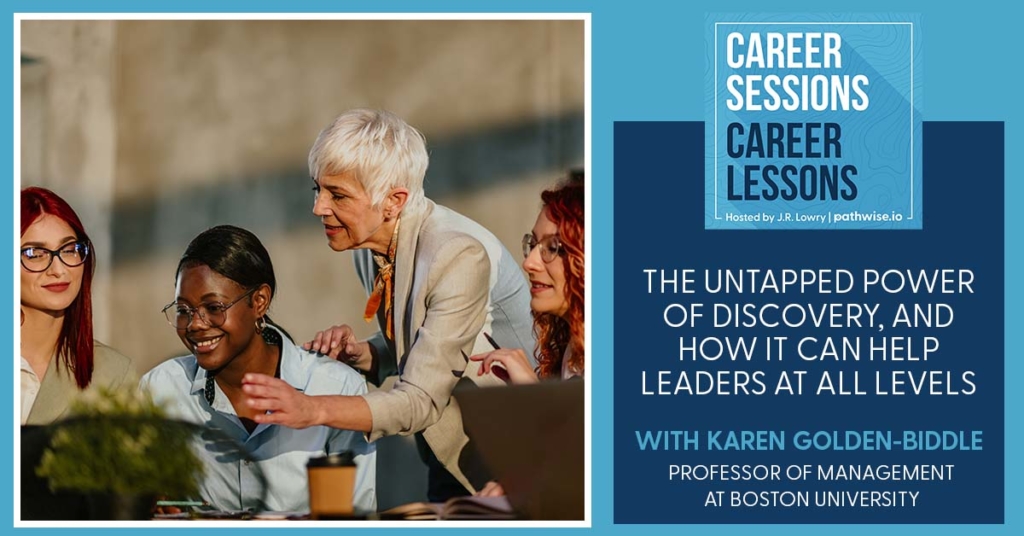
The Untapped Power Of Discovery, And How It Can Help Leaders At All Levels, With Karen Golden-Biddle
In this episode, host JR Lowry dives into the concept of embracing organizational discovery with Karen Golden-Biddle, a Professor of Management at Boston University. Karen shares insights from her research and upcoming book, The Untapped Power of Discovery, exploring how organizations can unleash creativity and drive change by integrating discovery processes into their operations. Tune in to learn how embracing the unknown can transform the way we approach challenges and foster innovation in any organization.
Check out the full series of “Career Sessions, Career Lessons” podcasts here or visit pathwise.io/podcast/. A full written transcript of this episode is also available at https://pathwise.io/podcasts/the-untapped-power-of-discovery-and-how-it-can-help-leaders-at-all-levels-with-karen-golden-biddle.
—
Watch the episode here
Listen to the episode here
The Untapped Power Of Discovery, And How It Can Help Leaders At All Levels, With Karen Golden-Biddle
Fellow Of The Human Resources Policy Institute At The Questrom School Of Business At Boston University
Introduction To Karen Golden-Biddle
This show is brought to you by PathWise.io. If you want more from your career, take control and visit PathWise. My guest is Karen Golden-Biddle. Karen is a Professor of Management and Organizations, emerita, and Fellow of the Human Resources Policy Institute at the Questrom School of Business at Boston University. She conducts research and teaches at the graduate level in areas of cultural change and qualitative methodology. She has a forthcoming book, The Untapped Power of Discovery, aimed at leaders at all levels and organizations and communities that we’ll be focusing on in this episode. Karen, welcome. Thanks so much for joining me on the show.
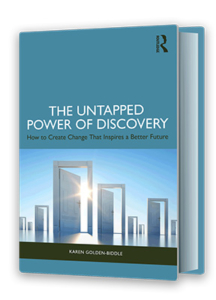
Organizational Discovery: The Untapped Power of Discovery: How to Create Change That Inspires a Better Future.
Thank you. I’m delighted to be here.
I am as well. I’m looking forward to talking about your work and your book. Let’s start by talking about your work. What’s keeping you busy?
I am helping people and organizations cultivate the practice of discovery. I’m loving it. It’s my passion going forward to bring this out into the public realm. I’m using education, classes, courses, teaching, and training. I’m building a website that will have resources and certainly, research and writing. Fireside chats too at the number of things. Anything that will bring this out is what I’m about.
The book that you are publishing or coming out is about discovery. Do you want to tell us a little bit about it and what sparked writing it?
Unleashing The Creative Power Of Discovery
It’s a new way of understanding discovery. That’s where I would start. It’s about unleashing the creative power of this new way. We normally think of discovery as an end result or the outcome, the breakthrough technology, novel vaccine, new product innovation, and those kinds of things. It’s the end result. We never really unpack. We keep it a mystery about how we discover, not what we discover. That whole process unleashes the creative power. It’s an inventive process that we make a little bit about this. It’s an inventive power for change. That’s the piece about what it’s about.
There are dozens of stories of people who have used the discovery process, whether they have indicated that or not or knew it at the time. Some did and some didn’t. They wove it through a change process. It’s not a change model itself. It’s the mechanism that helps change become creative. That led to the spark because I didn’t start out to study discovery. I studied change. I study it like an ethnographer. I go into organizations to study about them.

Karen Golden-Biddle: Discovery is not a change model; it’s the mechanism that helps change become creative.
When I was there, I witnessed a number of unfortunate well-intentioned change initiatives that failed. They failed, I started to see, for maybe some of the obvious reasons, but there were a number of them that failed. It was not because they lacked leadership support or because they lacked resources, or even that they had gotten employee engagement. They had technically done all the things right and it still didn’t light the spark or the insight to take it to the next level about what their expectations and hopes for that change would be.
I went on a search because statistics told us at least 15% of cultural change initiatives succeed. We focused on the 85% that don’t. Of those change initiatives that require a belief change, 15% succeed. I wanted to find out about that. I wanted to see that. I started searching and I came across an organization that I thought was a healthcare system. I thought maybe it would be something that would use discovery. They were in the midst of a strategic planning process to look at their future relevance.
The spark is that I went in to study the organization and watched this change process evolve over time from, “We’re going to fix the patient care delivery system a little bit. We’re pretty good. We can get rid of some obstacles and then we’re fine. We’re relevant for the future.” Anything coming forward to awakening and evolving through the time to come to produce a creative, very innovative model of care that became quite well-known and written about and people would come to visit.
That whole process taught me the power of discovery. They helped me discover the true power of discovery and that creative evolution to something innovative that went through their efforts. They used Lean management, which was a value-to system, but they used it in a different way. That’s what got my attention about it. They used it with discovery.
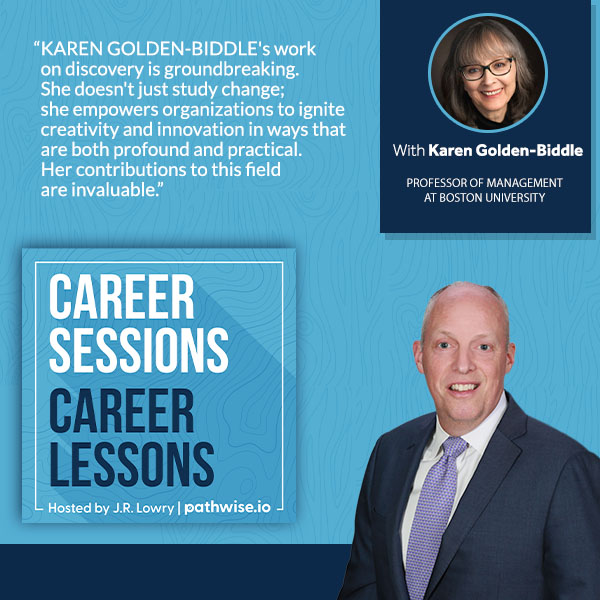
It’s an amazing story, especially hearing these stories in the healthcare realm because the outcomes ultimately improve patient care and life and death. It matters a lot, especially in that industry. Often, despite best intentions, we suppress discovery or maybe subject it to something resembling benign neglect rather than cultivating it. Why does that happen?
There are a lot of reasons. Some are our beliefs about discovery and who can do discovery. We constrain it to a limited number. Another is the belief that it’s an outcome so we don’t deal with discovery. There are two that are particularly important for organizations, whether they’re community-based organizations, corporate, or whatever but any kind of organizing system for this.
Discovery is an inventive process. Organizations, wherever they are, have evaluative processes too. These are processes that measure production planning, performance appraisal, goal setting, and those kinds of things that bring systematic kinds of things to bear, which we need. Inventive processes are different. Discovery is an inventive process. The growth mindset that Microsoft has used is also an inventive process or an inventive concept.
The idea is that organizations need both of these inventive and evaluative processes. Frankly, given the pressures, organizations are under predictability or profitability, making things systematic, being guaranteed product delivery, and so forth, which is critical. Those have pushed out discovery so that organizations overemphasize the evaluative processes.
Anybody in an organization inclined for discovery needs to deal with the evaluative processes. We know when we use both, like that hospital did with Lean and with discovery, we produce better solutions. There’s no question about the research on that. We do produce better solutions, but instead, we hide them. We push discovery over to the side or relegate it to departments or certain people who can designate it, and then say we’re doing it. That’s one. That’s the system level of why we would derail discovery.
The other one is as humans, it’s uncomfortable for us to go into the unknown. It’s scary sometimes. It’s downright problematic to enter the unknown. We are taught to know, not how to not know. As professionals, we are taught that in spades. The whole training faculty is taught that over the many years. We see that. Management schools mostly teach evaluative processes. It’s the occasional course that doesn’t. We need both. When we’re uncomfortable with discovery, moving into the doubt part of it or the unknown, then we shy away from it. Managers don’t like processes with good reason that they don’t know the outcome. It’s this not-knowing piece.
You had some great quotes in the book. One of them that is relevant to bring up here is the idea that people become prisoners to their expectations. We get so grounded in our way of thinking that we don’t question things. You don’t look for the unexpected. I could almost feel you leading up to it and then there was the old experiment from the ‘60s or ‘70s where the gorilla walks through the middle of a bunch of people.
Too often, we're prisoners to our expectations, unable to see the unexpected. It’s time to break free and embrace the unknown. Share on X
It’s an updated version of it.
I watched that happen live. I never saw the gorilla. When they played it back, you’re like, “How the heck did I miss that?”
Exactly. I did the same thing after I knew about discovery. I was like, “Whoa.”
We want to find patterns. Patterns are a mental simplifying trick. The problem with patterns is that you fall into them. You want something to fit into them and you don’t necessarily say, “This doesn’t fit at all.” It takes work to do that.
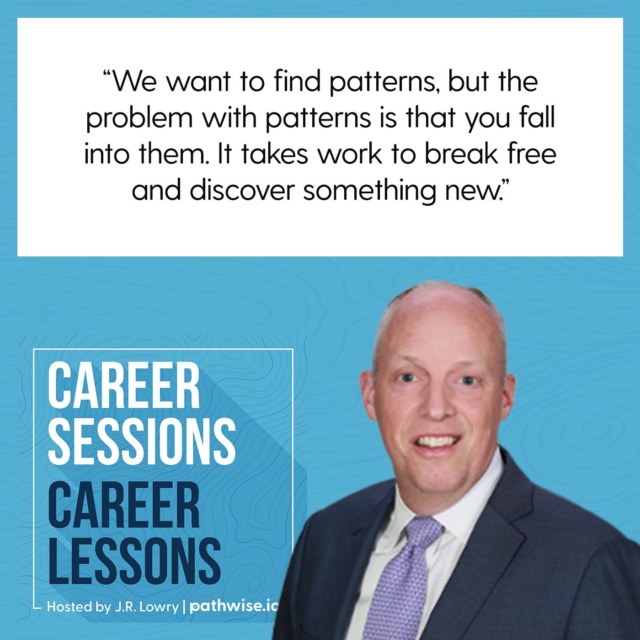
I do some work with faculty and doctoral students who use qualitative data in the research on how to gently theorize in the coding. We are very good in our training at helping people see the patterns and inductively generate patterns, but woefully, we’re behind the times in terms of discovery.
You said this right at the beginning of it. We have to be willing to fearlessly upend our beliefs.
Did I say fearlessly? I forgot.
I don’t know if you said fearlessly. Maybe I added the word fearlessly. You have another quote that I thought was appropriate. It’s this notion that those who do not know the torment of the unknown cannot have the joy of discovery. It highlights the fact that you do have to go into this uncomfortable place to tear apart the things that you’ve believed either historically or in the moment to find new ways.
To your point, we are accustomed to our patterns. We are held captive. We hold ourselves captive by our beliefs. We don’t just hold them, but we are held captive by them. That was the prisoner thing. When we’re that way, it’s a belief rigidity. All of us do this. In some way at some time, we can’t even imagine that our beliefs might be in error or how they might be in error. We rule out that situation.
I’ll share another quote. John Patrick Shanley, the Pulitzer Prize-winning playwright of the play Doubt, and also director of the same movie, said, “Certainty is a closed door. It’s the end of the conversation. Doubt is an open door. It’s a dynamic process.” That’s the inspiration for the book cover. It’s a series of open doors. We need to enter the open door to unleash the power of discovery, but it’s frightening. What I’ve seen in all of these stories and a number of others that I’ve been collecting since then is that it’s very helpful to walk into the unknown together. It’s not just your own experience about that because then you succumb and move into self-doubt.
The healthcare system, for example. We’re talking about beliefs. I’m not talking about religious, ideological, or political beliefs. I’m talking about everyday beliefs. They had the belief that they could map the care flows in their system. It’s very straightforward. It would be like when they went into that week-long retreat, they said, “We’re not going to be out of here. We know how to map the care flows in our system.” They couldn’t do it. They had great difficulties with the hand-offs in a number of places. They realized each one of them had a little area that they knew, but they didn’t know the whole system.
When we get that surprise, we say, “We recognize it, but how do we respond to it? We can respond to derail discovery or open it up.” They could have said, “Let’s look in the literature and see what the best practices are. Let’s delegate it to somebody else to figure it out.” They could have explained it away as “It’s an artifact of the exercise that we’ve been doing.”
Instead, they made the turn to discovery right then and they entered doubt. They entered doubt together by saying, “We don’t know why we had difficulty. We didn’t expect it. It is a belief that we shouldn’t have had difficulty, so we don’t know.” It was then that they explored and walked the care flow with patients. They made the choice.
We have two choices when we look at discovery and moving into doubt from surprise. Do we recognize the surprise for what it is? Do we respond to the surprising situation? Do we respond in a way that helps us move into doubt, that engages doubt, and that gets us into discovery-oriented questions? They did that, and then it moved from there. They continue to evolve into an innovative model.
You’ve covered 2 of the 3 motors as you described them in the book.
They’re wonderfully connected. You go back and forth.
Maybe give a quick summary for the audience’s benefit of what those three are because they frame a lot of the rest of the book.
Understanding The Three Motors Of Discovery
I call it the belief cycle. I’m drawing on some work from Charles Peirce who was a pragmatist in the past and then extending it for organizations. It’s the notion that we have this belief going in like they had this belief that they could map the care flows. We then have experiences that challenge those beliefs. If they don’t challenge the beliefs, that’s fine. You don’t need discovery. You don’t enter discovery. When the experience would challenge our beliefs, then we have choices. That’s a surprising situation. We have choices. Do we go on and enter doubt, which is the second motor, or do we stay and move away from doubt and look at the third motor?
Surprise is the first motor. It ignites discovery. Doubt is the second motor where it fuels discovery. That’s where all the questions come in. The possibilities and the new ideas start to ruminate. You build prototypes and models. Imagination is huge in discovery. Curiosity is huge in surprise. Imagination is huge in doubt. You move on to looking at some of the more possible ways of operating that are different than you have been doing. Those are the new possibilities, the novel options that you might have. Those are launching new ways.
Launching is not merely implementing. It’s a continuation of the discovery cycle. We often think discovery happens only at the beginning, especially with change, but whether we use it or not, we have the opportunity to discover all the way through, including by bringing it to fruition and making it a real possibility. That’s the third motor.

Karen Golden-Biddle: We often think discovery happens only at the beginning of change, but we have the opportunity to discover all the way through.
The first one of those is the surprise. Leaders so often try to reduce surprises. You talk about the no-surprises rule, which is predicated on the belief that surprises are bad. What’s needed to get people to embrace surprise?
It’s probably first to recognize that surprise is an opportunity for discovery. It’s not pushed aside around that. We do have a lot of organizations that say, “Surprises are unpredictable. They pop up.” There are some ways that you can set situations up for a surprise to possibly occur, and I provide some examples, but most are emergent on purpose. The whole process is dynamic. When they come in, if we can recognize a surprise for what it is, then surprise can teach us. We learn from experience through surprise. We see that, and then we say, “How do we respond to it? What kind of surprise is it?”
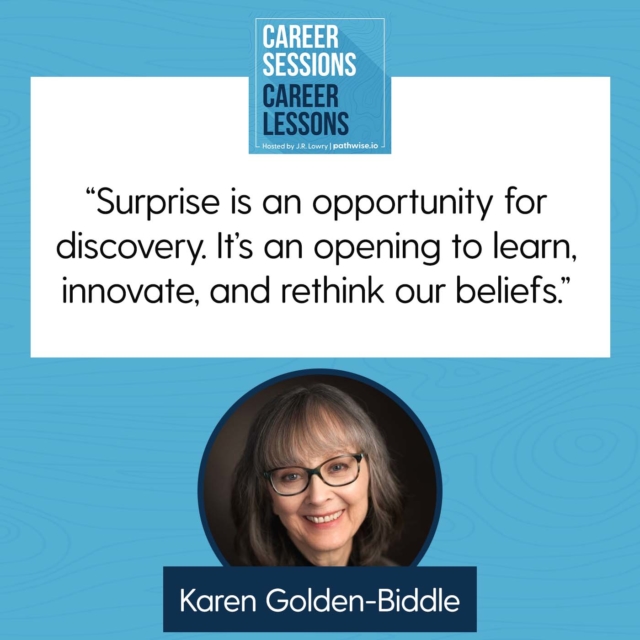
I was talking with an executive who talked about his team. They had been encountering loads of surprises, one after another in these days of constant shifting. He said, “We’re getting burnout. We have so many surprises.” The one thing about surprise is you don’t have to respond to every surprise or go into surprise. You can look at it and evaluate it with evaluative processes to say, “Is it a blind alley that we shouldn’t spend time on it too much?” We go down a little way and say, “Not it,” or do we pursue it because it may be worth it for the team? That helps bring some stability to what would otherwise be too much dynamism in the team. Those are some ways. You need to respond to it. I’m thinking of Scott Cook here a little bit with Intuit.
Tell that story because it was a good illustration of that.
It took them years at Intuit. They had produced Quicken and they wanted to survey their customers to see how they were using it and so forth. Some very surprising results came back from that survey where more than half of the customers used Quicken, which was a home financial product. They used different work a number of times. That survey came back. The response by Cook and the leadership team was, “That can’t be. There’s no way.” They missed it and went on with things.
As surprises do, if they start to impact us and not stay out there, then they niggle at us. Scott Cook talks about that. It stays with us. It’s a little uncomfortable feeling like, “What’s going on here?” It’s puzzling. You’re like, “I don’t know what’s happening here. How come it’s happening so frequently?” They finally said through this that they would go observe what the customers were doing. That’s a very similar practice to what the healthcare system did when they went to observe and walk with patients. They were walking with their customers not just to walk through, but with a discovery mindset. It was like, “We want to figure out and observe what’s happening.”
They went there and found a practice that they said they had never before imagined. That practice was that the customers were using Quicken in the office, doing the books of their small business. It was the accounting books of their small business. That flew in the face of a belief of Intuit. They had never imagined that practice because they assumed and believed that everyone would be using regular accounting practices for their businesses. The small businesses were not doing it that way. They were able to do their books with the home financial product.
After all that time, when they went to observe, they were able to not just see what they were doing, but to be able to reflect back on themselves and say, “This tells us our belief is not true.” That led to this insight of a giant market opportunity, QuickBooks. They’re still a predominant product, but they never would’ve discovered that market opportunity if they hadn’t gone through the process of discovery.
That then leads into the next branch where you can either poo-poo the surprise or embrace it and acknowledge doubt. This is another thing that is an anathema to a lot of leaders. We’re trained to know. We’re not trained not to know. A lot of leaders find a lot of discomfort in admitting that they might not know because they feel like they need to know everything. How do people overcome that? What have you seen in that 15% that are successful that they embrace what allows them to accept that they may not know?
Oftentimes, leaders feel that they have to know. Those are their expectations about it. What we do know is too much confidence or too little confidence is a problem. It’s an issue with that. It was Karl Weick who wrote about this initially about balancing. It makes it more practical. It helps to argue as if you’re right and listen as if you’re wrong. It’s this practice where you recognize your knowledge may be fallible. More people are recognizing that no one executive can know everything. That’s the piece of that. That’s one way to do it. The other is when you experience surprise and move into doubt in a group, the group helps. Everybody is like, “What’s going on?” That’s a piece of it. To avoid blind arrogance would be from know-it-all.
Argue as if you're right, but listen as if you're wrong. It’s this balance that fuels true discovery and innovation. Share on X
You contrasted that in the book with the learn-it-all culture that Satya Nadella at Microsoft put in place. That’s made a huge difference for them.
Their know-it-all culture didn’t have doubt. There was no space to doubt. They had an internal competition with each other before Nadella. This know-it-all is not a growth and development learning model, and all of their systems went along with that. He has been moving from a know-it-all culture to a learn-it-all culture. In the notion of a cultural change, it helps to have something so succinct as we’re going from this to that.
There are a lot of reasons why that organization works. He started in 2014 with this in an interview and a message to employees. We’ll take it apart for discovery. He said, “Culturally, we have operated as if we had the formula figured out.” That’s evaluative. That’s predictive. It was all about optimizing that formula in its various constituent parts. He then said, “Now, It is about discovering the new formula.” It was a formula that would allow for innovation. They have a culture of innovation at this point in what they’re doing, which is the learn-it-all. They use that and fuse that in the HR systems in many other systems around.
There are many other quotes from Nadella about how it’s not a fake kind of change. Employees are saying this. It’s a change that benefits their own growth and development. They’re even saying things like it’s helping them be better family members. It has a basis in the human condition or human situation about that. They feel like they can grow and develop in that culture.
It was Walt Whitman who said, “Be curious, not judgmental.” Stephen Covey, one of his seven rules is, “Seek first to understand.” There is a theme here that is played out about this idea. You referenced Carol Dweck’s work on growth mindset earlier. It’s about being open to possibility. It does take work to cultivate that and to fight what we were talking about earlier, which is that mental model “I want to fit things into a neat pattern because it’s easier for my brain” thing.
It takes doing it with others. I finished a two-and-a-half-day workshop with doctoral students around this. They said, “I thought I was doing my coding wrong.” I hear that with execs as well. They’re like, “I thought I was going about this the wrong way because I didn’t know about discovery.” In science, we’re taught validation. We’re not taught discovery.
A similar analogy is evaluative versus inventive in organizations. We don’t think of them that way, but they are. Once we know that, we can sort it out. It helps tremendously as a relief. That comes with knowing that difference and that we can switch back and forth and bring them in partnership with each other. It does help to learn how to cultivate discovery in a group with others and practice it.
There’s a balancing act that you have to strike too. You can get mired in self-doubt. You get stuck in analysis paralysis or whatever you want to call it. You had this message in the book about having to balance between believing and doubting and almost doing both at the same time. It’s like living in a quantum state of belief and doubt.
Not quite. We certainly want to be aware of them when there’s too much doubt. Self-doubt is about doubting ourselves. We need antidotes to self-doubt. All of us need antidotes to self-doubt. A lot of those colleagueship conferences or working groups that work well are wonderful antidotes to self-doubt because we doubt ourselves, not our ideas. We may doubt everything, our ideas as well. Generative doubt or genuine doubt also impacts us, but it’s about doubting our ideas or our beliefs, not who we are. The balance is to not move into that debilitating doubt and stay with a confident humility. Adam Grant coined the term confident humility.
I like that.
It’s a lovely togetherness of those two words.
That framework was something that I had not seen before, the 2×2 that you have in the book that talks about confident humility. It’s a good representation of that balance. It’s important for you to strike as you’re going about the day-to-day and trying to keep an open mind on things but not get yourself too much spinning in circles.
You could do that every day and practice that. A takeaway would be to practice confident humility, so not immediately saying, “That won’t work,” for example. It’s listening as if you’re wrong and arguing as if you’re right. It’s hearing what may be an error for you. You’re confident in who you are and humble knowing that your beliefs may be fallible. We see this and sometimes the lack of it in the return to the office issue. That never seems to go away. It doesn’t go away because we need to discover and not judge what’s going on.
I want to take some of the organizations and run a discovery process within what they’re doing anyway around that. When a perennial issue surfaces, this is about the assumptions and beliefs about where and how we work, how we control employees or not, and what managing looks like. It’s such a sweet spot for all those beliefs.
I was looking at our company’s employee survey data. For the third year in a row, remote work or hybrid work comes up very prominently. Both sides have dug in. There’s the belief that senior managers want people in the office all the time and the belief that productivity is best at home. We’ve tried to strike a balance. We’re having a debate over how many days in terms of that topic. It does not go away.
You said it. We’ve dug in. Everybody has belief rigidity. We are captive to our own beliefs at that point. We are the prisoners. We talked about our expectations. The first step is to loosen that. It sounds like your organization and some others as well are looking at options and various ways to bring people together.
Launching New Ways Through Discovery
I’m not sure we’ll please everybody out there. The last motor is about launching new ways. You’ve already talked about the fact that you need to do that in a real-world setting and with other people so you can talk it through. It can be difficult to put yourself in the shoes of the people in the field. There is another good quote from Marguerite Duras. She said, “The art of seeing has to be learned.” How do people learn how to see?
Something came right to my mind. After I got my MBA, I worked for a Fortune 200 corporation in the Human Resources Organization Development Department. The CEO had learned that you walk around or somebody told them to do that. He walked around.
That was Tom Peters’s Management By Walking Around. That was In Search of Excellence.
He walked around not in a way that he engaged much. Everybody whose office was coming could see him look at the name of the office and then not go in and say, “My name is. Who are you?” It was so awkward. People were sympathetic and appreciated him trying, but the coaching would have been helpful in engaging. When I say, “Go to the site,” it’s to do two things. One is to learn and try to grab hold of in some way the lived experience of the other person.
Oftentimes, what people will do in these stories is go to the place where the change will impact or the site of impact. You’ll go and try to understand the situation and not just wait until after the change to get buy-in. You’re in a convincing mode. Here, you’re trying to access user experience. That’s one way that discovery could change the change process.
You go early and periodically access, try out, test ideas, and look and see what they’re doing so that you are creating the change. You may then even involve people in the change process as it works out so that you’re creating the best kind of solution or the better kind of solution. One is you want to observe and get a feel for the everyday experience of the people in those situations.
The second one is not thought about as much, but what we are to do is to reflect back. We’ve been looking, observing, and engaging. We also want to reflect back so that we can see how this experience might be challenging our expectations and our beliefs. For example, the change that we were thinking about doing, which has happened in every system.
When we go out with that two-way directional communication, then we revise. We reimagine, rethink, or reorient what we’ve been doing to better adjust and be adaptive to the situations in which the change will be situated later. The obvious one is software. We’re like, “We have it, and we’re going to put it in.” There are many other ways that we could go about doing that.
This is where agile software development came into play. It’s the idea of doing more frequent releases and testing whether they work. Too often, you build, throw it out there, and feel like, “It’s the user’s fault. They aren’t making use of the system.” You don’t meet them where they are and try to understand, “Why aren’t you using the system?” or “Why are you using it differently than we expected you to?”
That iterative process or the Lean startup construct of constantly testing things and doing it in a very empirical fashion is a powerful concept in business in general. Otherwise, you go on a set of assumptions and keep going further. You sunk more energy into pushing your assumptions whether they were right or not.
That’s a great point about that because it’s a process or a way to go through to test those. The iterating of it is the critical piece.
In the last part of the book, you start to talk about instituting a process of discovery. You talk about the need to mobilize to create capacity. What are some of the things that entail, creating capacity in an organization for discovery?
The story for that chapter is about a global collaboration to eradicate some diseases. It’s about capacity anywhere. I was trying to say, “How do we do this at a larger scale? What are the pieces?” It is thoroughly relational around that. We have the discovery cycle. We have a notion of confident humility. We have this respectful engagement that people would have with each other. It’s this relational piece of knitting together interaction by interaction a way of responding and being with each other that fosters discovery and the capacity. You help the other and they help you build your own capacity and the group’s capacity in discovery. To me, that’s the richness of the walk into the unknown together. You build cultures that way when that happens.
You have ways of talking about it. There’s empathic listening. My colleagues, Jane Dutton, Monica Worline, and others have come forward with empathic listening with compassion. That has been shown as well as respectful engagement to spur discovery or to spur more ideas coming forward. Through their research and others, we have evidence of the new ideas coming forward through a process that involves respectful engagement on their part.
Empathic listening and respectful engagement aren't just nice-to-haves—they're crucial for fostering discovery and innovation. Share on X
Where I saw it in the case was that there were public health scientists who went in and heard some of the people’s beliefs about the disease that didn’t “fit” science. Rather than saying, “You’re wrong,” which would’ve derailed everything, they took that respectful engagement and their own confidence in the knowledge of science to be able to engage in a conversation rather than to say, “You’re wrong. How did you come to know that?” They could build it into the education program, which was more than telling. It was very much doing and practicing around areas of knowing about the disease and how they could avoid the disease. The disease rate has gone down to fifteen a year. They’re very close to eradicating it.
It was done in a way where they heard the on-the-ground perspective and confronted some of the non-scientific beliefs in a respectful way. They involved the villagers in these different places where this disease was a problem and got them to be part of the evangelizing.
They then brought other people in. The villagers innovated in ways that the collaboration could not have even thought about innovating. They innovated other ways of avoiding the disease. This is with the eradication of dracunculiasis, the Guinea worm disease. That is a devastating disease. The leaders of this initial collaboration and the scientists have this respectful engagement as a sincere part of who they are. They act that way and it cascades out versus maybe other collaborations that come in and tell villagers what to do or tell others in that locale what they need to do. That’s not respectful engagement. I’m incredibly inspired by this. It’s relational. It taught me more than any case about how relational matter with discovery or the trust of others.
You said at the outset that you came into this whole journey focusing on change and wanting to understand why some change initiatives succeed, a few of them, the 15%. That brought you into this voyage of discovery yourself. If you bring it back to change, what are the implications that you’ve discovered for change management?
The Role Of Discovery In Effective Change Management
There are many. At least there are a few that are most important to talk about. It is not a change model, and I’m not trying to make it a change model. It is a process that is woven through. That’s at the base. It is a process that needs to be woven through the change process for new ideas to emerge. To generate anything new, we need discovery. We need that inventive process. We may adjust on the margin or we may bring or import something new, but to generate truly new, we need to alter one of our beliefs in the process. That’s why we need discovery for that.
With change then, one that I mentioned earlier is we need to go earlier in the process of change to the place where change is going to be implemented. People are starting to do that more. It’s to truly engage or respectfully engage people who are going to be implementing it and bringing them to the committees or however we do it. It’s not to get into the issue of trying to create buy-in for it and look at the number of adopters we have or get them on the bus. That happens. There will be people who never come on, but we want to engage them and understand the user experience, not gain buy-in after the fact.
The other one is that we want to see that discovery happens all the way through the change process. I don’t know of a single change model that has discovery all the way through. I have studies that I’ve done and the one in the Academy of Management Journal shows the discovery flowing all the way through and how it evolves. In some cases, it evolves the purpose. Discovery, potentially, can work all the way through unless we cut it off at the beginning. Some models don’t have it at all. That’s a piece of it.
One that strikes home to me, because this is how we’ve done it in academia and I know of other places in other organizations, is that we separate this design and implementation committee. The designers, like in faculty, traditionally are the elite faculty kind of thing. They don’t want to get their hands dirty with the implementation. They’ll maybe teach it, but they’re going to design the content. Other faculty who are not full-time faculty will do the implementation after the effect. That proves wholly problematic. It never delivers the best result or the best solutions.
We have the phases but we don’t need this strict demarcation between this and that because it’s not a strict deal. It is iterative. It keeps coming around. Those are some ways around the change process. The healthcare system knitted the discovery process and Lean management together. Others are enhancing the discovery process with design thinking and bringing more discovery into that way of thinking, which already is advanced for innovation.
Coming back to what this means for leaders, one of the things that struck me is that you want to create this openness to surprise that turns to doubt or that turns to consider new ways. Yet, the day-to-day work still needs to happen. You have to balance action and decisions versus questioning and investigation. What did you see in the organizations that you’ve studied about how they keep the trains running every day but still maintain an institutional openness that enables that process of discovery?
To a tee, every one of them knitted discovery into the work that they were doing. They didn’t have a separate discovery project unless they were like Kronos at the time. UKG was trying to reinvent itself, but they still knit it. You have something that’s clearly designated. They bring it together. They were doing strategic planning in the healthcare system. They are trying to eradicate diseases. They are trying to figure out what customers are doing. I could think about the other ones.
To truly innovate, we must intertwine discovery with our everyday work, not treat it as a separate project. Share on X
When they don’t knit it together, they derail the discovery. They get better solutions. That’s the ideal. It’s to bring both the evaluative and the inventive together. It’s a way with decades, but Six Sigma failed because it didn’t bring in inventive processes. It had evaluative processes. The critique was it was great for efficiency but not for creativity.
What we’re trying to do is bring those together every day so that we don’t put work aside. We choose carefully when we want to bring in discovery to help that work. That’s the biggest learning from these organizations because then it’s sustainable to do it. It’s not like, “I’ll get to discovery on Monday or Wednesday.” It’s like, “This project might need us to be more intentional about discovery or the inventive process that we’re using.”
You point out the fact that they need to be intertwined so that it’s not at the expense of the other. People can operate seamlessly doing a bit of both every day.
We need to know about them before we can bring them together. That’s starting to happen, which I’m excited about. All these have done that.
For an individual thinking about this in the context of managing their career choices, what advice would you give them?
Final Thoughts On Discovery And Career Growth
It’s essential to grow, develop, and thrive in these times of many unexpected situations and know how to manage ambiguity and people in the career process. To me, it’s an important process to be able not just to survive but to thrive to keep developing and growing. This has shown that choosing discovery and these stories have shown how you choose discovery unleashes our deep creativity for change. That’s what we want to bring forward because it inspires better futures. Everyone benefits from it.
It’s not easy. It requires persistence and a willingness to challenge and potentially change. We don’t have to talk through the default change or change beliefs. It also requires the courage to try. These stories and the ones that I continue to find are worth it. The clinicians are saying, “I’ve been trying to operate this way as a clinician ever since I graduated from the school. Now, I can be the nurse I want to be with this.” There’s a definite clinical outcome but also a professional outcome when we work together for discovery. I wish everyone tuning in with many insights, a-has, and new perspectives as you cultivate a practice of discovery.
It’s late June 2024 as we’re recording. Is the book out?
It will be out soon.
You said in the beginning that you’ve got a website and a toolkit that you’re building. Do you want to take a minute and give us a quick summary of that?
The website is going to hold resources. It’s got a great discovery quiz that you can go on and take. I encourage people. My website is KarenGolden-Biddle.com. You can go on and do the discovery quiz. I will host resources. The discussion guide is going up soon. It’s going to host other kinds of curricular things, short-term and long-term practices that you could do to cultivate discovery, and some of the things we’ve talked about here. As soon as the launch finishes, I’m going to move into building the website. The book you referenced, Think Again, by Adam Grant is another one. I’m in the process of doing an annotated bibliography of discovery resources to read, podcasts, and those kinds of things.
Thank you for doing the show with me.
Thank you. I appreciated our conversation.
I enjoyed the book and enjoyed the conversation. Thanks and have a good day.
You as well.
‐‐‐
I want to thank Karen for joining me to discuss her new book, The Untapped Power of Discovery. If you’d like to pursue your own path of discovery, visit PathWise.io and become a member. Basic membership is free. You can also sign up on the website for the PathWise newsletter and follow us on LinkedIn, Facebook, YouTube, Instagram, and TikTok. Thanks.
Important Links:
- Karen Golden-Biddle
- The Untapped Power of Discovery
- In Search of Excellence
- Think Again
- LinkedIn – PathWise
- Facebook – PathWise.io
- YouTube – PathWise-io
- Instagram – PathWise
- TikTok – PathWise
- https://KarenGolden-Biddle.com/Discovery-Quiz/
About Karen Golden-Biddle
